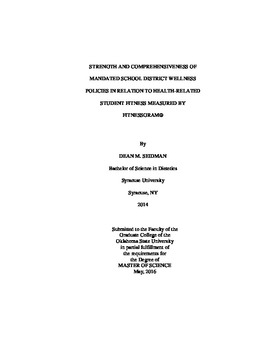| dc.contributor.advisor | Fink, Kevin | |
| dc.contributor.author | Seidman, Dean Michael | |
| dc.date.accessioned | 2017-02-22T22:16:20Z | |
| dc.date.available | 2017-02-22T22:16:20Z | |
| dc.date.issued | 2016-05-01 | |
| dc.identifier.uri | https://hdl.handle.net/11244/49153 | |
| dc.description.abstract | School wellness policies (SWPs) are documents developed by school districts with the objective of addressing nutrition and physical activity. The Child Nutrition and WIC Reauthorization Act of 2004 (CNRA) was passed by the U.S. Congress which required schools to possess a SWP by the 2006-2007 school year. Since passage of the CNRA, health outcomes of students such as obesity, have been of interest. This study sought to see if there is a connection between the strength and comprehensiveness of SWPs and physical fitness in students, as measured by Fitnessgram�. Physical fitness assessed by Fitnessgram� is determined by conducting six tests with the goal of meeting the healthy fitness zone (HFZ) for each test. Students (N=747) were obtained from twenty-seven districts that received funding from Physical Education Program (PEP) grants to conduct Fitnessgram� testing and review SWPs. SWPs were evaluated using the Wellness School Assessment tool (WellSAT), generating two scores, strength and comprehensiveness (Rudd Center, n.d.). Data was analyzed using two methods: 1) Linear regression analysis with clustered robust standard error at the individual level, and 2) Bivariate correlation analysis with student fitness scores aggregated at the district level. Mean SWP strength (x?=24.13) and comprehensiveness (x?=48.91) from schools assessed in Oklahoma were lower than other states (Schwartz et al., 2012). Regression analysis showed there was no relationship between attainment of the HFZ and strength (p=0.18) or comprehensiveness (p=0.18), however gender and attainment of the HFZ was significantly correlated (p=0.04). The correlation analysis further confirmed that there was no relationship between mean attainment of the HFZ and strength (r=0.14, p=0.48) or comprehensiveness (r=0.14, p=0.48). Although physical fitness can be related to childhood obesity, results from this study suggest SWPs in Oklahoma are not strong or comprehensive enough to facilitate change in student fitness. School districts should consider enhancing opportunities for physical activity and physical education not only in the school, but also among the home and community environments. | |
| dc.format | application/pdf | |
| dc.language | en_US | |
| dc.rights | Copyright is held by the author who has granted the Oklahoma State University Library the non-exclusive right to share this material in its institutional repository. Contact Digital Library Services at lib-dls@okstate.edu or 405-744-9161 for the permission policy on the use, reproduction or distribution of this material. | |
| dc.title | Strength and Comprehensiveness of Mandated School District Wellness Policies in Relation to Health-related Student Fitness Measured by Fitnessgram� | |
| dc.contributor.committeeMember | Hildebrand, Deana | |
| dc.contributor.committeeMember | Betts, Nancy | |
| osu.filename | Seidman_okstate_0664M_14472.pdf | |
| osu.accesstype | Open Access | |
| dc.description.department | Nutritional Science | |
| dc.type.genre | Thesis | |
| dc.type.material | text | |
